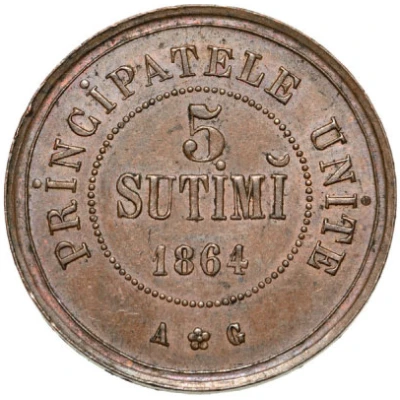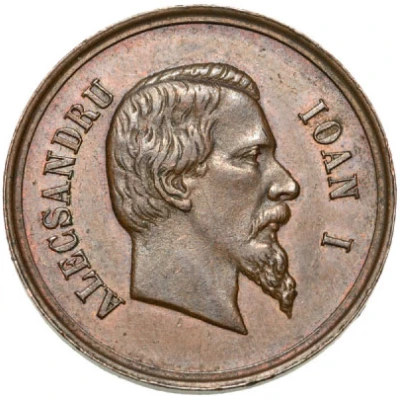


© La Galerie Numismatique
5 Sutimi - Alexandru Ioan Cuza Pattern
1864 year| Bronze | 7.28 g | 22.5 mm |
| Issuer | United Principalities of Moldavia and Wallachia (Romania) |
|---|---|
| Prince | Alexander Joan Cuza (Alexandru Ioan Cuza) (1859-1862) |
| Type | Pattern |
| Year | 1864 |
| Value | 5 Sutimi (0.05) |
| Currency | United Principalities Român |
| Composition | Bronze |
| Weight | 7.28 g |
| Diameter | 22.5 mm |
| Shape | Round |
| Technique | Milled |
| Demonetized | Yes |
| Updated | 2024-10-07 |
| Numista | N#197210 |
|---|---|
| Rarity index | 93% |
Reverse
Portrait of the ruling prince facing right.
Script: Latin
Lettering: ALECSANDRU IOAN I
Translation: Alexandru Ioan I
Edge
Plain
Comment
One piece in private ownership is reported to weigh 7.28g. The piece in the Union Museum in Iaşi, Romania is reported to weigh 5.7g.In the 1st half of the 19th century more than 70 types of foreign coins circulated in Moldova and Wallachia. These were mainly currencies from neighboring countries: Austria, Turkey and Russia, but also from France, England and other European states. Even coins that were no longer legal tender in the issuing states were accepted in circulation in the Romanian principalities. The foreign currencies had a negative effect on the local economy, and the exchange rate constantly fluctuated. Several attempts at monetary reform failed before 1867.
In this context, in 1859-1860, Alexandru Ioan Cuza, the elected Ruling Prince of the United Principalities, made a first attempt to introduce a local currency. The consul of the French Empire in Iaşi, Victor Place, a Filo-Romanian, backed the project. With his support, the decimal monetary system of France was adopted, and the coins were to be minted in Paris. The monetary unit, according to the model of the French franc, had to be called Român (Romanian) or Romanat, and would be divided into Sutimi (cents).
All projects were drawn in 1860 by the French numismatist Adrien de Longpérier, curator at the numismatic cabinet of the Louvre Museum, a friend of Place. In 1864, a new attempt at reform resulted in the 5-Sutimi Pattern being minted. A 10 Sutimi pattern from 1864 may also exist
The engraver of these patterns is not known. "AG" may stand for an "Atelier de Gravure" in Paris. Between 1855 and 1878, the chief engraver of the Paris mint was Désiré-Albert Barre. But his privy mark, the anchor, is missing from this pattern. Another theory is that the initials are in fact "AC", for Armand Auguste Caqué (1793-1881). But he also regularly signed CAQUE F and not AC.
Interesting fact
One interesting fact about the Pattern 5 Sutimi - Alexandru Ioan Cuza (Pattern) 1864 from United Principalities of Moldavia and Wallachia (Romania) made of Bronze weighing 7.28 g is that it features a unique design, showcasing the bust of Alexandru Ioan Cuza, the first Domnitor (Prince) of the United Principalities of Moldavia and Wallachia, surrounded by an ornate wreath. This design was only used on a few coins during Cuza's reign, making it a rare and sought-after collector's item among numismatists.